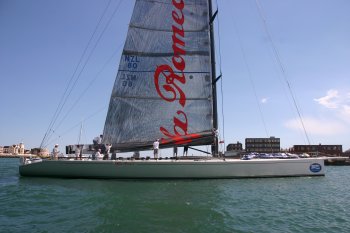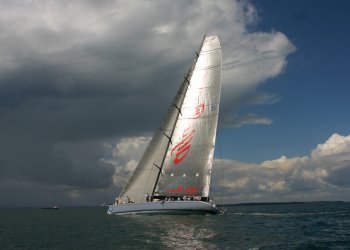|
The RORC Race
Office announced during yesterday (Saturday) afternoon’s Race
& Weather briefing that the Rolex Fastnet Race start
will be postponed for 25 hours due to the continued
severe weather warning issued by the UK Met office. The
first start for the 300 boat fleet will be Monday 13
August at 1100 BST.
The postponement is a first in the 83-year history of
the race. The decision was made after consideration of
the severe weather warnings issued by the UK Met Office,
in order to ensure that the fleet is not in the exposed
waters of the Western Channel and the Celtic Sea at the
time that the predicted weather is expected.
RORC Racing Manager, Janet Grosvenor said: “it remains
the RORC policy to start the race when it is safe to do
so and the responsibility for a boat’s decision to
participate in the race or to continue racing is hers
alone.”
With the forecast boding a fast race, plans for the
finish in Plymouth remain in place with the prizegiving
scheduled for Friday17th August at the historic Royal
Citadel.
Most sailing pundits are eagerly
anticipating the match-up between the stunning 30 metre
canting keelers, Mike Slade’s brand-new Farr-designed
ICAP Leopard and Neville Crichton’s latest Reichel
Pugh-designed Alfa Romeo, which has had a string of wins
since her launch two years ago.
The
Fastnet is respected even in beautiful weather maybe
because of its slightly gloomy air and its history
rich in sinister episodes. The lighthouse was built
in 1848 in the midst of the Victorian Age. It is
just four miles off the south coast of Ireland, a
short distance which is however potentially rich in
surprises for those who dare to sail this small
stretch of sea.
|
 |
|
Most sailing pundits are eagerly
anticipating the match-up between the stunning 30 metre
canting keelers, Mike Slade’s new ICAP Leopard
and Neville Crichton’s Alfa Romeo, which has had a string of wins
since her launch two years ago.
Photo: Pre-race training on the Solent last week. |
|
|
 |
|
Alfa Romeo will have to bide time in her
victory bid as the Rolex Fastnet Race start has been
postponed for 25 hours due to the continued severe
weather warning issued by the UK Met office.
Photo: Pre-race training on the Solent last week. |
|
|
The Fastnet fortress was built to
make sailing towards the commercial harbours of Cork
and Dublin safer. The tower rises 40 metres out of
the water and the signal can be seen 28 miles away.
It is the furthermost point of Irish territory, the
only land to the west being the United States.
The lighthouse that now tops the Fastnet fortress is
not the original version as designed by Irish
engineer George Halpin, on commission from the
Corporation for Preserving and Improving the Port
of Dublin, which financed the project with 18
thousand sterling. In 1881, a storm tore away the
highest part of the lighthouse and the go-ahead was
given for rebuilding 10 years later. The work was
concluded in 1904 with the first illumination on
June 21 1904. To make the light strong enough to
resist the strength of the sea, 4,633 tonnes of
granite were used. An immense and complex job.
Since
1925 not only has the lighthouse been an important
point of reference for safeguarding people at sea,
but it is also the buoy to round in the Fastnet
regatta that departs from Cowes and arrives in
Plymouth. Around the Fastnet rocks, the weather is
unpredictable, also because of its geographical
position which makes it easy prey for the Azores
anticyclone and the banks of cloud and turbulent
fronts that often arrive from the Atlantic with
surprising speed.
|
|
|
|
![]()
![]()